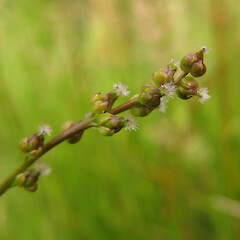Triglochin palustris
Common name
marsh arrow grass
Synonyms
Triglochin palustre L.
Family
Juncaginaceae
Flora category
Vascular – Native
Endemic taxon
No
Endemic genus
No
Endemic family
No
Structural class
Herbs - Monocots
NVS code
The National Vegetation Survey (NVS) Databank is a physical archive and electronic databank containing records of over 94,000 vegetation survey plots - including data from over 19,000 permanent plots. NVS maintains a standard set of species code abbreviations that correspond to standard scientific plant names from the Ngä Tipu o Aotearoa - New Zealand Plants database.
TRIPAL
Chromosome number
2n = 24
Current conservation status
The conservation status of all known New Zealand vascular plant taxa at the rank of species and below were reassessed in 2017 using the New Zealand Threat Classification System (NZTCS) – more information about this can be found on the NZTCS website. This report includes a statistical summary and brief notes on changes since 2012 and replaces all previous NZTCS lists for vascular plants.
Please note, threat classifications are often suggested by authors when publications fall between NZTCS assessment periods – an interim threat classification status has not been assessed by the NZTCS panel.
- Conservation status of New Zealand indigenous vascular plants, 2017 . 2018. Peter J. de Lange, Jeremy R. Rolfe, John W. Barkla, Shannel P. Courtney, Paul D. Champion, Leon R. Perrie, Sarah M. Beadel, Kerry A. Ford, Ilse Breitwieser, Ines Schönberger, Rowan Hindmarsh-Walls, Peter B. Heenan and Kate Ladley. Department of Conservation. Source: NZTCS and licensed by DOC for reuse under the Creative Commons Attribution 4.0 International licence.
2017 | Threatened – Nationally Critical | Qualifiers: DP, RR, SO, Sp
Previous conservation statuses
2012 | Threatened – Nationally Critical | Qualifiers: RR, SO, Sp
2009 | Threatened – Nationally Critical | Qualifiers: SO, DP
2004 | Threatened – Nationally Endangered
Distribution
Indigenous. In New Zealand known only from the eastern side of the South Island, where it has been reported from South Canterbury, Northern and Central Otago.
Common in the Northern Hemisphere and South America.
Habitat
Montane wetlands. Found growing along the sides of slow flowing streams, on tarn and lake margins and in sphagnum bogs.
Wetland plant indicator status rating
Information derived from the revised national wetland plant list prepared to assist councils in delineating and monitoring wetlands (Clarkson et al., 2021 Manaaki Whenua – Landcare Research Contract Report LC3975 for Hawke’s Bay Regional Council). The national plant list categorises plants by the extent to which they are found in wetlands and not ‘drylands’. The indicator status ratings are OBL (obligate wetland), FACW (facultative wetland), FAC (facultative), FACU (facultative upland), and UPL (obligate upland). If you have suggestions for the Wetland Indicator Status Rating, please contact: [Enable JavaScript to view protected content]
OBL: Obligate Wetland
Almost always is a hydrophyte, rarely in uplands (non-wetlands).
Detailed description
Summer green, erect, slender, bulbous herb forming small colonies. Leaves dark green to reddish-green, 50-500(-800) x 0.5-1 mm diam., fleshy, semicircular or slightly channelled in cross-section. Ligules undivided, subacute. Inflorescence arising on a stout peduncule 25-260(-400) mm long; racemose, with raceme more or less equal to peduncle length. Flowers pedicellate, pedicels up to 6 mm long, closely appressed to peduncle axis. Flowers c. 3 mm long, dark green to wine-red. Fruit 80-100 x 1 mm, narrow-linear, with the 3 fertile follicles unkeeled, dorsifixed, partially separating from the base, resulting in an arrow shaped structure.
Similar taxa
A distinctive species, immediately recognised by the arrow-head fruits borne on a long slender raceme are imemdiately diagnostic. Occasionally Triglochin striata may grow inland in similar habitats. It is a much smaller plant, lacking a bulbous base, with rounded leaf ligules, and fruits that are subglobose rather than arrow-shaped.
Flowering
December to February
Flower colours
Green, Red/Pink
Fruiting
December to March
Propagation technique
Can be grown in damp soil or partially submerged pots from divisions or whole plants. Fresh seed should germinate easily.
Threats
Herbarium records indicate that this species has always been localised. However, it is also easily overlooked. Nevertheless some Canterbury sites have vanished and in some of the Otago sites the species is very vulnerable to weed invasion of its wetland habit. Very few populations occur on protected land, and many are accessible to livestock which greedily eat plants.
Etymology
triglochin: Three-pointed
palustris: From the Latin palus ‘swamp’, meaning growing in swamps
Where To Buy
Not commericially available.
Attribution
Description adapted from Moore and Edgar (1970).
References and further reading
Moore, L.B.; Edgar, E. 1970: Flora of New Zealand. Vol. I. Government Printer, Wellington.















